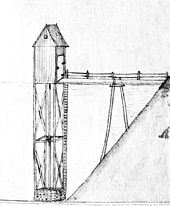Harrowing system
A harrow system is a closure organ of artificial ponds of small dam systems. They are either freely accessible or surrounded by small huts, the so-called harrow house or harrow house. The gate valves of the old dams of the Freiberg Revierwasserlaufanstalt and the Unterharzer pond and ditch system have been called that from time immemorial.
The system consists of a harrow , pin and pull spindle . The harrow run is the bottom outlet of the reservoir. For this purpose, thick oak trunks were cut out with an ax, provided with a cover and then compacted with turf and moss. A rich loam-clay mixture seals the harrow curling further and preserves it. Cast iron and concrete drains were later used. The pin ( gate valve ) is let into the harrow run . A rod (pull spindle) is led up through a shaft. This pin from the harrow house can be used via thispulled out or lowered. In this way the flow rate is regulated.
In the Oberharzer Wasserregal there were two types of harrow systems, which depended on the type of pond. In the old construction, which was used until around 1700, the dam had an outer seal and the harrow house, which was connected to the dam via a footbridge, stood in the water. In the newer ponds, the dam had an inner seal and the harrow house stood on the dam.
Picture gallery
Dam of the crane pond near Hahnenklee with old-style harrowing system, harrowing house in the water
Dittmannsdorfer pond with Striegelhaus on the dam
Cross-section of the Oderteich dam with a new type of harrow system, harrow house on the dam
Old-style harrowing system, Carler pond, Clausthal-Zellerfeld
literature
- Rolf Meurer: Hydraulic engineering and water management in Germany . Parey Buchverlag, Berlin 2000, ISBN 3-8263-3303-9 .
- Wilfried Ließmann: Historical mining in the Harz . 3rd edition, Springer Verlag, Berlin and Heidelberg 2010, ISBN 978-3-540-31327-4 .
Web links
- Justus Teicke: Das Oberharzer Wasserregal (accessed on February 22, 2016)






